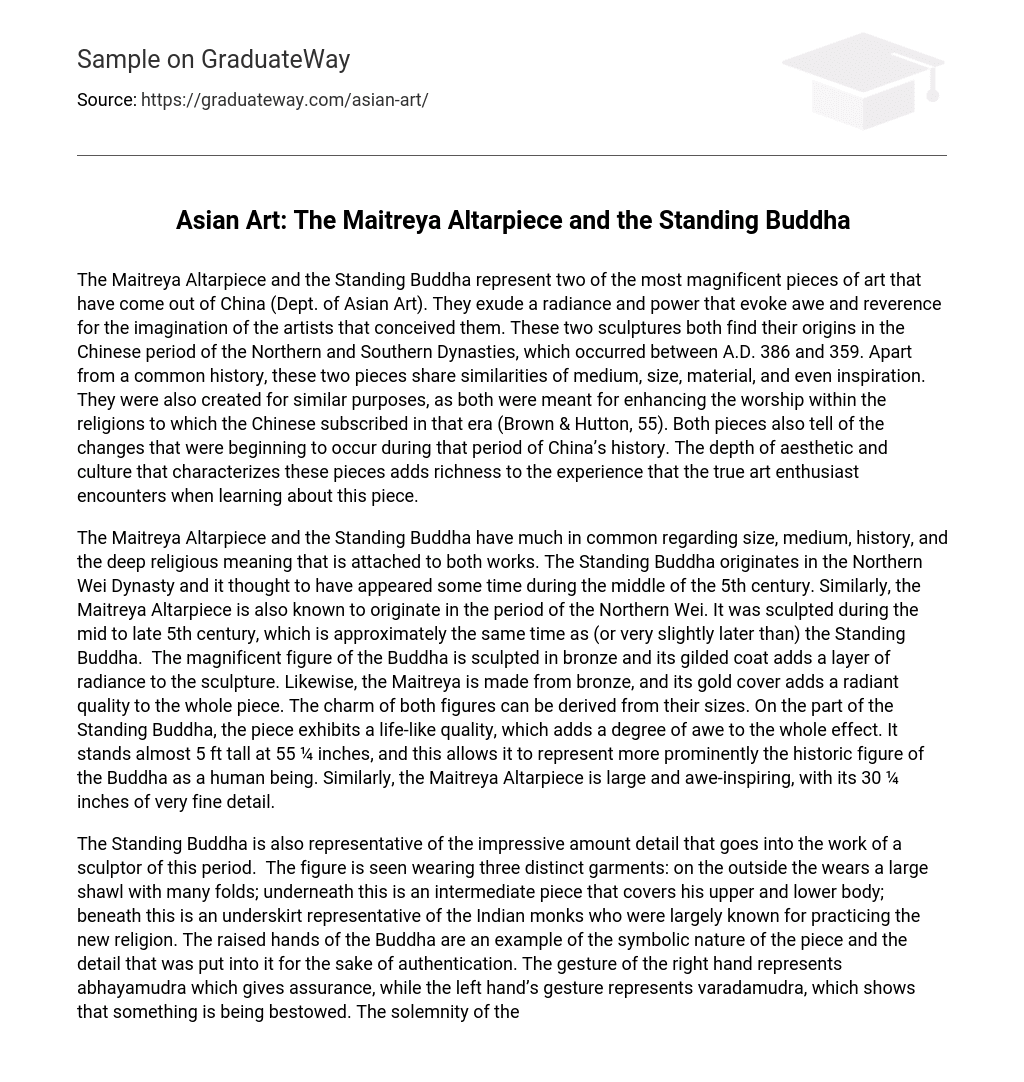The Maitreya Altarpiece and the Standing Buddha represent two of the most magnificent pieces of art that have come out of China (Dept. of Asian Art). They exude a radiance and power that evoke awe and reverence for the imagination of the artists that conceived them. These two sculptures both find their origins in the Chinese period of the Northern and Southern Dynasties, which occurred between A.D. 386 and 359. Apart from a common history, these two pieces share similarities of medium, size, material, and even inspiration. They were also created for similar purposes, as both were meant for enhancing the worship within the religions to which the Chinese subscribed in that era (Brown & Hutton, 55). Both pieces also tell of the changes that were beginning to occur during that period of China’s history. The depth of aesthetic and culture that characterizes these pieces adds richness to the experience that the true art enthusiast encounters when learning about this piece.
The Maitreya Altarpiece and the Standing Buddha have much in common regarding size, medium, history, and the deep religious meaning that is attached to both works. The Standing Buddha originates in the Northern Wei Dynasty and it thought to have appeared some time during the middle of the 5th century. Similarly, the Maitreya Altarpiece is also known to originate in the period of the Northern Wei. It was sculpted during the mid to late 5th century, which is approximately the same time as (or very slightly later than) the Standing Buddha. The magnificent figure of the Buddha is sculpted in bronze and its gilded coat adds a layer of radiance to the sculpture. Likewise, the Maitreya is made from bronze, and its gold cover adds a radiant quality to the whole piece. The charm of both figures can be derived from their sizes. On the part of the Standing Buddha, the piece exhibits a life-like quality, which adds a degree of awe to the whole effect. It stands almost 5 ft tall at 55 ¼ inches, and this allows it to represent more prominently the historic figure of the Buddha as a human being. Similarly, the Maitreya Altarpiece is large and awe-inspiring, with its 30 ¼ inches of very fine detail.
The Standing Buddha is also representative of the impressive amount detail that goes into the work of a sculptor of this period. The figure is seen wearing three distinct garments: on the outside the wears a large shawl with many folds; underneath this is an intermediate piece that covers his upper and lower body; beneath this is an underskirt representative of the Indian monks who were largely known for practicing the new religion. The raised hands of the Buddha are an example of the symbolic nature of the piece and the detail that was put into it for the sake of authentication. The gesture of the right hand represents abhayamudra which gives assurance, while the left hand’s gesture represents varadamudra, which shows that something is being bestowed. The solemnity of the sculptures’ religious meaning is therefore enhanced through the preservation of such detail in the artwork. The serenity of this figure’s facial appearance also adds to the solemnity of the atmosphere, thereby adding an air of unity to the work (Dept. of Asian Art).
The Maitreya Altarpiece might also be considered as evoking an air of solemnity as it too contains symbolic features that are sacred parts of the Buddhist religion. It, like the Indian Buddha, was created by a non-Chinese tribe that aided in the migration of the Buddhist religion to China. This altarpiece contains a figure of the Buddha is hallowed by the mandorla background that majestically arches above him. He too is represented as making hand gestures that symbolize assurance and the giving of gifts to those who worship him. In addition to this, the symmetry of the human figure is accented by the similar bodhisattvas that flank him on either side, and the additional symmetry of the mandorla’s Gothic arch also adds to the symmetric unity of this piece (Menzies, 92). In addition to the previously mentioned similarities to the Standing Buddha, the solemnity of this religious piece is also emphasized. This is done through the presence of nine angels perched on the mandorla’s rim and whose music making flutter up to the heavenly realm—to which the whole seems to point (92). The layered aspect of the Maitreya Buddha’s clothing demonstrates another level of similarity to the Standing Buddha (Dept. of Asian Art).
The fact that the Maitreya Altarpiece and the Standing Buddha were modeled after the Indian makes them highly representative of the Chinese Art of that period (Dept. of Asian Art). This period of art also represents the changes that were taking place within the Chinese culture. The older form of art was slowly morphing into a newer and more sophisticated form, and this was occurring alongside the opening up of relationships between the Northern and Southern parts of China. As a result of this, influences from other sections of China (and indeed other parts of Asia) were infiltrating the Northern Wei dynastic culture, making themselves visible in the art. One such influence is seen in the above sculptures with their Indian Buddhas. At this time, many immigrants from India were coming into region of the Northern and Southern Dynasties for purposes of trade and (more relevantly) to spread the Buddhist religion within this region. The artistic efforts put into the carving of these magnificent pieces are testimony of the extent to which these missionaries succeeded.
References
Brown, Rebecca & Deborah Hutton. Asian Art: An Anthology. Wiley-Blackwell, 2006.
Department of Asian Art. “Period of the Northern and Southern Dynasties (386–589)”. In Timeline of Art History. New York: The Metropolitan Museum of Art, 2000–. http://www.metmuseum.org/toah/hd/nsdy/hd_nsdy.htm (October 2002)
Menzies, Jackie. Buddha: Radiant Awakening. Sydney: Art Gallery of New South Wales, 2003.





